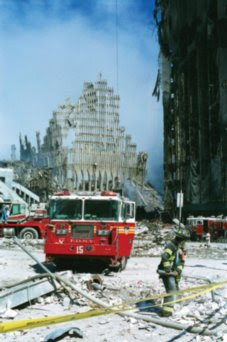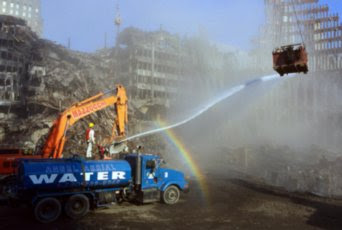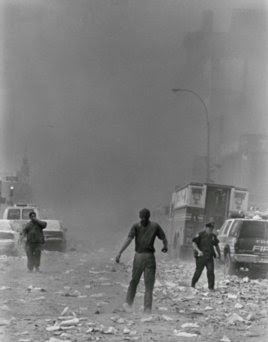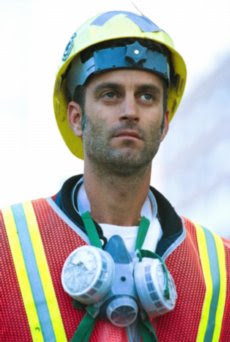A completely new resource for me is a six-year-old effort at awarding honors for taking pictures on September 11, 2001, and its aftermath---
The Best of Photojournalism 2002. The
Internet Archive has never heard of these pages before, so I don't know when they went up online. Almost the whole batch is unfamiliar to me (and where they are familiar, they are all part of the same entry,) which leads me to think they are of recent public vintage.

During the first days after September 11th, the job of removing mountains of burning rubble seemed endless. Today, after five months of continuous labor by workers like the one featured here, most of debris at ground zero has been removed. Next comes the difficult task of determining what will be built in the place of the fallen World Trade Center.

A team of fire fighters standing on the remains of the World Trade Center's north tower scan the smoking rubble for the bodies of those who were killed by the terrorist attacks of September 11th.

In the immediate wake of the terrorist attacks of September 11th, New York City fire fighters, police officers and construction workers faced the daunting task of finding survivors and cleaning up the burning rubble that was once the World Trade Center. Without hesitation these workers rose to the occasion and embraced their call to duty. In the six months that have passed since Semptember 11th these men and women have labored night and day to clean up ground zero. When historians sit down to write about September 11th and its aftermath, they will have to reserve a page of History for the workers at ground zero whose tireless efforts saved lives and helped rebuild New York City. Flanked by the remains of the World Trade Center's south tower, a fire fighter removes debris two days after the destruction of the World Trade Center.

A worker walks through the debris littered atrium of the Winter Garden, the beautiful greenhouse that was adjacent to the Twin Towers before September 11. Remarkably, the glass building sustained very little damage given its proximity to the World Trade Center and delicate structure.

Water is sprayed into a cloud of dust immediately after workers used machinery to pull down a large portion of the iconic skeletal frame of the World Trade Center's north tower.

An Ironworker cuts through the last remaining vertical portions of the World Trade Center's south tower.

Nearly a month after the terrorist attacks on the World Trade Center, workers continued to cut through smoking debris, which frequently burned at temperatures above 1100 degrees Fahrenheit.

A road worker directs a truck onto the pile at ground zero during the middle of the night. Trucks removed hundreds of tons of debris daily to a barge that transferred the material to Fresh Kills landfill on Staten Island.



Working through the night an Ironworker cuts through part of a steel girder that was gathered from the rubble pile at ground zero.

Brett Perry, weary from more than forty-eight hours of continous work at ground zero stares blankly at debris from the fallen World Trade Center.

After toiling night and day for a week at ground zero, many workers like these fire fighters became frustrated and dstraught by the emotional weight of finding survivors in such a hopeless situation.
 During the first days after September 11th, the job of removing mountains of burning rubble seemed endless. Today, after five months of continuous labor by workers like the one featured here, most of debris at ground zero has been removed. Next comes the difficult task of determining what will be built in the place of the fallen World Trade Center.
During the first days after September 11th, the job of removing mountains of burning rubble seemed endless. Today, after five months of continuous labor by workers like the one featured here, most of debris at ground zero has been removed. Next comes the difficult task of determining what will be built in the place of the fallen World Trade Center. A team of fire fighters standing on the remains of the World Trade Center's north tower scan the smoking rubble for the bodies of those who were killed by the terrorist attacks of September 11th.
A team of fire fighters standing on the remains of the World Trade Center's north tower scan the smoking rubble for the bodies of those who were killed by the terrorist attacks of September 11th. In the immediate wake of the terrorist attacks of September 11th, New York City fire fighters, police officers and construction workers faced the daunting task of finding survivors and cleaning up the burning rubble that was once the World Trade Center. Without hesitation these workers rose to the occasion and embraced their call to duty. In the six months that have passed since Semptember 11th these men and women have labored night and day to clean up ground zero. When historians sit down to write about September 11th and its aftermath, they will have to reserve a page of History for the workers at ground zero whose tireless efforts saved lives and helped rebuild New York City. Flanked by the remains of the World Trade Center's south tower, a fire fighter removes debris two days after the destruction of the World Trade Center.
In the immediate wake of the terrorist attacks of September 11th, New York City fire fighters, police officers and construction workers faced the daunting task of finding survivors and cleaning up the burning rubble that was once the World Trade Center. Without hesitation these workers rose to the occasion and embraced their call to duty. In the six months that have passed since Semptember 11th these men and women have labored night and day to clean up ground zero. When historians sit down to write about September 11th and its aftermath, they will have to reserve a page of History for the workers at ground zero whose tireless efforts saved lives and helped rebuild New York City. Flanked by the remains of the World Trade Center's south tower, a fire fighter removes debris two days after the destruction of the World Trade Center. A worker walks through the debris littered atrium of the Winter Garden, the beautiful greenhouse that was adjacent to the Twin Towers before September 11. Remarkably, the glass building sustained very little damage given its proximity to the World Trade Center and delicate structure.
A worker walks through the debris littered atrium of the Winter Garden, the beautiful greenhouse that was adjacent to the Twin Towers before September 11. Remarkably, the glass building sustained very little damage given its proximity to the World Trade Center and delicate structure. Water is sprayed into a cloud of dust immediately after workers used machinery to pull down a large portion of the iconic skeletal frame of the World Trade Center's north tower.
Water is sprayed into a cloud of dust immediately after workers used machinery to pull down a large portion of the iconic skeletal frame of the World Trade Center's north tower. An Ironworker cuts through the last remaining vertical portions of the World Trade Center's south tower.
An Ironworker cuts through the last remaining vertical portions of the World Trade Center's south tower. Nearly a month after the terrorist attacks on the World Trade Center, workers continued to cut through smoking debris, which frequently burned at temperatures above 1100 degrees Fahrenheit.
Nearly a month after the terrorist attacks on the World Trade Center, workers continued to cut through smoking debris, which frequently burned at temperatures above 1100 degrees Fahrenheit. A road worker directs a truck onto the pile at ground zero during the middle of the night. Trucks removed hundreds of tons of debris daily to a barge that transferred the material to Fresh Kills landfill on Staten Island.
A road worker directs a truck onto the pile at ground zero during the middle of the night. Trucks removed hundreds of tons of debris daily to a barge that transferred the material to Fresh Kills landfill on Staten Island.

 Working through the night an Ironworker cuts through part of a steel girder that was gathered from the rubble pile at ground zero.
Working through the night an Ironworker cuts through part of a steel girder that was gathered from the rubble pile at ground zero. Brett Perry, weary from more than forty-eight hours of continous work at ground zero stares blankly at debris from the fallen World Trade Center.
Brett Perry, weary from more than forty-eight hours of continous work at ground zero stares blankly at debris from the fallen World Trade Center. After toiling night and day for a week at ground zero, many workers like these fire fighters became frustrated and dstraught by the emotional weight of finding survivors in such a hopeless situation.
After toiling night and day for a week at ground zero, many workers like these fire fighters became frustrated and dstraught by the emotional weight of finding survivors in such a hopeless situation.
No comments:
Post a Comment